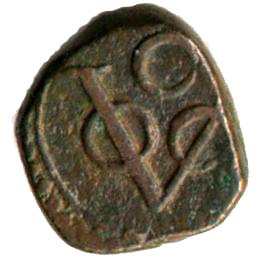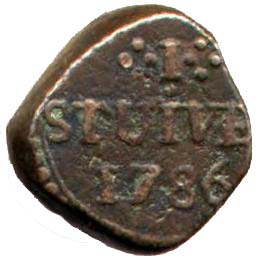| SPECIFICATIONS | |
| Denomination | One Stuiver |
| Alloy | Copper |
| Type | Struck |
| Diameter | 21. mm |
| Thickness | mm |
| Weight Legal | 13.35 gms |
| Weight | 13.76 gms |
| Shape | Round |
| Edge | Dump |
| DieAxis | O° |
| Mint | Colombo |


|

|

| ||||||||||||||||||||||||
| Schloten 1299b; Mitchiner #2187; Krause #26 | ||||||||||||||||||||||||||
Obverse : VOC monogram, below C (Colombo).
Reverse : .:. I .:. above STUIVE(R) above year 1786
Both sides within bead and line circles.
In October 1787 the Mint of Colombo was located In the "Bangzaal" near "Kaymans Poort", under the sworn minter Rynier Hendriksz.
VOC monogram of the Dutch East India Company has a large V superimposed on OC.
| KM26 | S1296a | R | 1783 | Die of fine workmanship |
| KM26 | S1296b | 1783 | Narrow monogram | |
| KM26 | S1296c | 1783 | Wide legend on rev., larger 7 | |
| KM26 | S1297a | R | 1784 | Die of fine workmanship |
| KM26 | S1797b | 1784 | Large lettering | |
| KM26 | S1298a | 1785 | small lettering (height 3 1/2 mm) | |
| KM26 | S1298b | 1785 | large lettering | |
| KM26 | S1298c | R | 1785 | Var. with SIUIVER |
| KM26 | S1299a | 1786 | small lettering | |
| KM26 | S1299b | 1786 | 6 longer | |
| KM26 | S1299c | 1786 | wide date | |
| KM26 | S1299d | 1786 | as c, larger lettering (4 mm) | |
| KM26 | S1300a | S | 1787 | |
| KM26 | S1300b | S | 1787 | small lettering |
| KM26 | S1301a | R | 1788 | |
| KM26 | S1301b | R | 1788 | no dot on I in STUWER |
| KM26 | S1301c | R | 1788 | small lettering (3 mm), the first 8 of the date reclining to l. |
| KM26 | S1302a | 1789 | small lettering | |
| KM26 | S1302b | 1789 | no dot on I | |
| KM26 | S1302c | 1789 | larger lettering | |
| KM26 | S1302d | 1789 | 8 and 9 below line | |
| KM26 | S1303a | 1790 | ||
| KM26 | S1303b | 1790 | thin lettering, 90 below line | |
| KM26 | S1303c | 1790 | with SIUIVER | |
| KM26 | S1304 | 1791 | with thick 9 | |
| KM26 | S1305a | S | 1792 | |
| KM26 | S1305b | R | 1792 | with SIUIVIR |
| KM26 | S1306a | R | 1793 | |
| KM26 | S1306b | RR | 1793 | with VOC below O |
| KM26 | S1307a | S | 1794 | |
| KM26 | S1307b | R | 1794 | with large 4 |
| KM26 | S1308a* | R | 1795 | crude lettering |
| KM26 | S1308b | R | 1795 | 95 smaller than the other numerals |
These coins were struck to meet the constantly increasing shortage of small change. Batavia sent word to Colombo, however, that as a sufficient number of Doits had arrived from Europe in the meantime, further coinage of copper Dudus, Larins and Bazarucos would be unnecessary. In 1787 Colombo replied that since there was nothing but copper in circulation, the supply of Doits would soon be exhausted; as there was no more Japanese copper available, it was decided to use the metal from old cannon. In 1788 Japanese copper was used again.
Text from
* Ceylon Coins and Currency By H. W. Codrington. Colombo 1924
Page 133 Chapter X Dutch - Coins of the Eastern Mints. Plate 130.
* The Coins of the Dutch Overseas Territories- 1601-1948
C. Scholten, 1953, Amsterdam: Jacques Schulman.
The coin was scanned at 300dpi and the images are displayed at 300dpi. It was purchased in April 1999 from the John Madlon collection of Dutch Ceylon copper dumps.